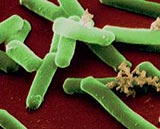Influenza

Clostridioides difficile is an anaerobic, spore-forming, gram-positive rod-shaped bacterium. Until August 2016, the bacterium was known as Clostridium difficile. Clostridioides difficile is found in the intestinal tract of humans and animals, but can also be found in soil or in water.
C. difficile can be found in the intestines of up to 80 per cent of young children. In adults, it is only about five per cent. During inpatient treatment in hospital, the proportion of colonised patients rises to 20 to 40 per cent. However, most infections are asymptomatic.
Under unfavourable conditions, C. difficile can form resistant permanent forms (spores). This is why a disinfectant with a sporicidal effect is required. Alcohol-based hand disinfectants only reduce the vegetative cells of C. difficile. Hand washing with simple soap is recommended to eliminate the spores.
C. difficile can cause different clinical pictures. Pathogenic C. difficile bacteria produce toxins that can lead to inflammation of the intestine. In addition to several diarrhoeal diseases (e.g. antibiotic-associated diarrhoea), these also include pseudomembranous colitis or intestinal obstruction. An infection with C. difficile can have serious consequences, as it can lead to sepsis, for example.
An illness with C. difficile is accompanied by severe diarrhoea with a characteristic odour. In addition, those affected experience high fever and severe abdominal pain.
A common cause of infection with C. difficile is antibiotic therapy. When broad-spectrum antibiotics are administered, the balance of the intestinal flora may be disturbed and the C. difficile bacteria that are present can overgrow the intestine due to a lack of competition. Symptoms appear two to ten days after the start of antibiotic treatment.
C. difficile are one of the most relevant pathogens for nosocomial diseases.
C. difficile is transmitted via the faecal-oral route. Transmission mainly takes place through direct or indirect contact with contaminated persons or surfaces.
In order to prevent direct contact between infected and non-infected persons, affected patients are isolated from other persons.
In particular, the rapid implementation of hygiene measures by nursing staff in the hospital is crucial to prevent infections with C. difficile.
Since the bacteria can also be transmitted through contact with surfaces, surfaces and objects close to the patient should be treated with disinfectants with a sporicidal effect.
